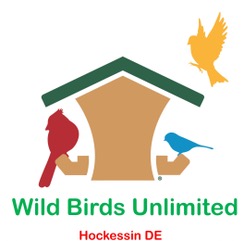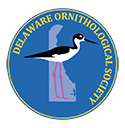
Urban Nesting Peregrine Falcons
Our Story
A nest box was installed on the Brandywine Building in Wilmington, DE in 1992 by Craig Koppie of USFWS due to recent falcon activities witnessed by individuals going to work in downtown. In January of 2010, a webcam was installed inside the box in the hopes of opening a window into the world of the Wilmington Peregrine Falcons for all of our viewers. Little did we know that during the peak viewing season (after those little darlings hatch!), the webcam would host over 40,000 viewers in a day from around the world!
See the bottom of the page for a detailed history of the Wilmington Falcons.
Annual Falcon Fledge Watch
Every year is a new experience and always filled with some drama, oftentimes a wild and exciting fledging event or two as the young falcons take that leap of faith for their first flight.
The best viewing vantage point to witness the fledging, flight lessons and feeding of the young falcons is from atop the City Center Parking Garage off of 11th Street directly across from the nest box.
There is a Wilmington Falcons page on Facebook. Visit for the lastest news on the falcons.
New Cameras!
Two new cameras have been installed to give views outside the nest box. These will really help when fleglings are present but they will also allow you a chance to see the adult falcons when they are outside the nest. Both outside cameras have programmed sequences to pan nearby roofs as you watch, however, an operator my take control of them to actively search for falcons.
Visit our YouTube channel during the nesting season to view the falcons:
Camera One

Camera Three (North Roof)

Camera Two

Camera Four (West Roof)

The Falcon Season
February – courtship begins with individual visits to the nest box, and nesting scrapes begin to appear. Mostly made by the male, the scrapes are circular depressions formed by the falcon lowering its chest and pushing the pebbles to form a cavity for the eggs to be laid. Later in the month, both falcons will appear and perform courtship bowing and vocalizations, oftentimes resulting in mating.
March – courtship and bonding behaviors continue and defense of the nest box and territory from interlopers can prove to be dramatic, resulting in a life-or-death battle. Egg-laying happens during this month and incubation begins. The falcons typically lay between 3-5 eggs, spaced 2-3 days apart. They don’t start incubating until they’ve laid their next to last egg. Both adults incubate the eggs with incubation lasting from 32-35 days from egg-laying.
April – Incubation continues for 32-35 days.
May thru June – Once the eyases (little new ones) appear, both adults will tend to the newborns. One adult may remain with the eyases until they are 10-11 days old before both adults will leave them to hunt. After losing their downy feathers, the falcons are then known as nestlings. They double their weight in only six days and at three weeks will be ten times birth size. The months of May and June will be extremely active months filled with activity from both the adults and the nestlings. Look for adults to bring food to the box about once an hour. Since the young falcons start to fly within 42 days of hatching, they will be going through wing-strengthening flapping on a very regular basis, oftentimes while standing on the outer ledge. The falcons can then be seen standing out on the edge of the box, acclimating themselves to the outside environment. At this time, the adults start to bait the youngsters out of the box on their one and only fledging flight, hopefully with a successful outcome! The adults will stop direct feeding of the young to encourage flight but continue to provide prey and teach the fledglings how to hunt.
July – Flight and hunting lessons continue but the young falcons are preparing for life on their own. Towards the end of July and into early August, the adults will start to encourage the young falcons to disperse and find a new territory they can call their own.
History of the Wilmington Falcons
U.S. Fish and Wildlife installed the nest box on Brandywine Building in 1992. There was no nesting activity reported until 1998. In 1998 and 1999 there were nesting attempts which failed. Successful nesting started occurring in 2002, with 3-5 fledges each year.
In 2010 the first nest camera was installed. That was also the arrival year for Red Girl, who hatched in Harrisburg in 2008. Her first clutch of 4 eggs failed to hatch when her mate, Caesar, disappeared during incubation. She then teamed up with a male called CJ. From 2011 - 2013 CJ and Red Girl produced five eggs each year. In their third year CJ disappeared during incubation. A new male, Trinity, arrived and fostered Red Girl and CJ's brood.
Trinity's arrival began an uninterrupted eight year partnership between Red Girl and Trinity. Every year they produced five eggs, except for 2014 and 2020, when they produced SIX each year. Trinity raised 39 successful fledges. Red Girl fledged 45. Red Girl and Trinity each had challenges during those years but were able to fend off the interlopers.
In 2022 Trinity and Red Girl produced five eggs, but both were challenged repeatedly during nesting season. Meeting those challenges meant the eggs were left uncovered too long and failed to hatch. Trinity disappeared that year and was replaced by Whitman. Late in 2022 Red Girl disappeared and an unbanded female took over. A month or so later the new female disappeared. Red Girl reurned but was obvious weakened and likely injured. After a short period she disappeared again, replaced by Bridget.
Whitman and Bridget laid 4 eggs very very late in the spring of 2023. Two did not hatch, and one hatchling died while hatching. Only one hatched, and we dubbed her "Solo" She fledged about a week too early and had to be rescued by Kim Steininger after her initial flight attempt. Solo drove the fledge watch volunteers nuts as she got herself into various "situations" for a week. She perservered, and became the only young peregrine from the Wilmington nest in two years.
During the off season in 2023 Whitman disappeared and was replaced by Newman. Newman and Bridget produced five eggs in 2024 but Newman went missing early in incubation and was replaced by a new banded male who hatched in 2013 at Philadelphia City Hall and has been named Phil.
As of this writing, the 5 eggs Bridget produced in 2024 with Newman are being ignored by Phil and their viability is in question. The male needs to help with incubation for the eggs to hatch.
We wish to express our great appreciation for our sponsors, without whom this project would not be possible:

|
 Wild Birds Unlimited/Hockessin Wild Birds Unlimited/Hockessin |
 Delaware Ornithological Society Delaware Ornithological Society |
 Jay Gundel and Associates |
 United States Fish & Wildlife Service |
 Buccini-Pollin Group |
…and numerous Facebook viewers and fans!
And a special thank you to Assurance Media for guidance and installation of the new cameras, and WHYFLY for hooking us up with awesome wireless streaming direct to you!
 |
 |
